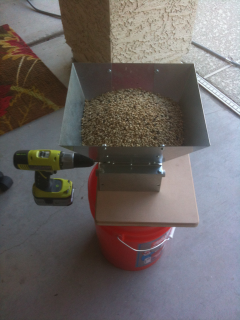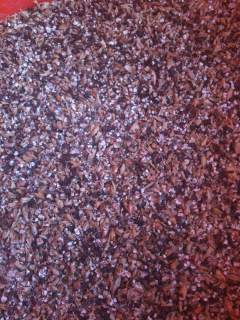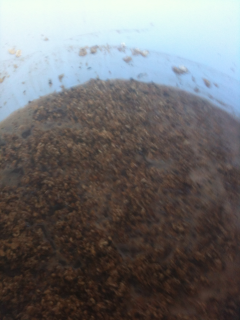Ole Mole
Today’s brew is a dark chocolate oatmeal stout, with vanilla bean and a touch of cayenne pepper.
The grain bill is about 14.25lbs, and includes Pale Ale Malt, Chocolate Malt, Flaked Oats, Carapils, Crystal 60, De-Bittered Black Malt,Crystal 45, and a smattering of Black Patent Malt in the mash. A single ounce of nugget hops provides the bittering and hop flavor, a Tbls of Cayenne for heat, and 4oz of Dark Cocoa round out the boil.
I started milling my grains, heating my strike water, and placing the two tubes of live yeast I had in the refrigerator on my counter to warm to room temperature. Once the water strike water was ready, I pre-heated my mash tun with about 3Gal of 190 degree water, swirled it around, let it set for about 5 minutes and dumped it out. I then added about 4.5Gal of water at about 168 degrees to the tun, mixed in my grain, stirred to make sure everything was properly wetted, and checked the temperature. 150 degrees, perfect. I covered the tun with an insulated lid, and other than stirring and checking the temperature every 15 minutes, let it sit for an hour.
| Now it’s time to recirculate the wort, in order to clear it and set the grain bed prior to transferring the wort to the boil kettle, This is known as the vorlauf. I use a wort pump to vorlauf and run it for about 10 minutes. | [hdplay id=2 ] |
Once the vorlauf is completed, I use the pump to transfer the wort to my boil kettle, and then add about 4.5gal of 170 degree water to the mash tun and stir the grain up to help extract as much of the fermentable sugars still in the grain into solution. This is known as a batch sparge. After letting the new mixture sit for about 10 minutes, I again vorlauf, and transfer the new wort to the boil kettle. The grain soaks up about 1.5-2gal of the water, so I’m left with 7.5-8gal in the brew kettle. I fire up the burner, and get the wort up to a roiling boil. I’ve also got my immersion chiller / whirlpool in the kettle to sanitize in the boiling sort. Over the next hour I add the hops and other flavorings at the appropriate time. At the end of the boil, I cool the wort quickly by running cold water through the immersion chiller, and running the wort through the whirlpool tube. This allows much of the precipitating solids formed by the boil, called trub, to settle in the center of the kettle away from my dip tube drain. |
| Once the wort has reached about 75 degrees,it’s time to transfer the work into the fermentation vessel, in this case a 6gal Better Bottle PET carboy. I prefer the plastic carboys, as they are easier to clean, and lighter and safer than the same size glass carboys. I then pitch in the two vials of White Labs WLP013 London Ale yeast into the carboy, use my oxygenating wand to stir the wort and add some dissolved oxygen into the wort, and place the whole shebang into my fermentation chamber. nothing to do now but wait for the yeast to do their magic. |
Day 8
Just took a refractometer reading, and a taste. Right now the ABV is at 7.8%, and the cayenne is pronounced. It should smooth out as time goes on, and when I add the vanilla bean extract.
Day 15
Moved the brew to a secondary barboy and took a sample. ABV is 8.5%, and the cayenne is diminished somewhat, but still prominment. Another couple of weeks, then I’ll add the vanilla extract, priming sugar and bottle it.
Bay 22
Dry Hop Day!! I took a 1gal paint strainer bag, soaked it in vodka to sanitize, added 1-3/4 oz each of Simcoe, Centennial, and Nugget hops, and a stainless steel ball bearing to help keep the bag submerged in the beer. Dropped it all in the carboy, and now I’ll wait 7-14 day to add priming sugar and bottle.
Day 35
Bottling Day!!
I took the carboy out of the fermentation chamber, and took a quick sample to taste. Smooth, medium viscosity, and just the right amount of bite from the cayenne. The vanilla nose and flavor had diminished a little more than I had hoped, but since this had happened to me the last time I used vanilla in my Dark Side Vanilla Bean Porter, I was ready for it. In goes another four ounces of Trader Joe’s Bourbon Vanilla Extract, and now it’s just right (for me at least, I love the taste of vanilla.)
I got together my bottles, Starsan sanitizer, priming sugar solution, and got to work.
First, I added the sugar priming solution. I make my priming solution well in advance, and pressure sterilize it in pint jars in my pressure cooker. That way come bottling day I just open a jar of priming solution, add it to the carboy, stir gently with a sanitized stirrer and let it sit for about an hour to allow any stirred up sediment to settle.
Next I sanitize my bottles using Starsan solution and a bottle sanitizer/rinser. This send a jet of sanitizer solution into the bottle, which will kill any nasties that may have crept into the bottle. The sanitizer works as long as it’s wet, so I normally do about 2 dozen bottles at a time.
Using a spring loaded bottle filler, I fill the bottles, automagically leaving just the proper amount of headspace in the bottle.
After I’ve filled the bottles, it’s time to cap them. I paid a little extra and got a Colonna Bottle Capper and Corker. This baby is great. It’s easy to use, can be adjusted for various bottle sizes, and can also cork wine bottles and Belgian Ale bottles. Definitely worth the money.
Now I move all of my bottles to my “Bottle Bomb Shelter”, a 100 quart cooler, to allow the bottles to naturally carbonate. This way, if I’ve miscalculated the amount of priming solution, or have a bottle failure (try “beer bottle bombs” in google for examples), the cooler will contain the mess. This saves endless hours of cleaning, and argument with SWMBO if a bottle bomb occurs.
Now just have to wait a couple of weeks to try the final product.
Day 49
Tasting Day!
I put a bottle of Ole Mole into the fridge at about 10AM, to let it cool down. At 3:30PM, I took the bottle from the fridge, opened it and poured a sample into one of my 7oz tasting glasses. The brew is a nice opaque brown-black, with a small dark tan head that quickly dissipates, with very little lacing.
The vanilla aroma presents itself as soon as the bottle is opened, and is predominate in the nose of the beer.
Taking a sip, the brew has a moderate to heavy mouthfeel, with a creamy viscosity, as it should with an oatmeal stout. Chocolate flavors are very muted, which surprises me, based on the amount of Belgian dark cocoa I used. Only after swallowing does the heat of the cayenne make itself known, but it definitely lets you know it’s there, and stays with you for a while. There’s a surprise return of the vanilla flavor that helps mediate the heat of the spice which is a pleasant surprise.
This is not a stout that you should drink by itself. It would probably contrast well with a meal like a molasses-based pulled pork, or sweet glazed chicken wings, the spice helping to reduce some of the cloying sweetness. I probably will use about half as much cayenne next time, and possibly use some chocolate extract in the secondary, as the chocolate is not where I hoped it would be.
Overall this is not one of my best efforts. It’s still young, and the cayenne heat has definitely reduced with time, so maybe some cellaring will help.



